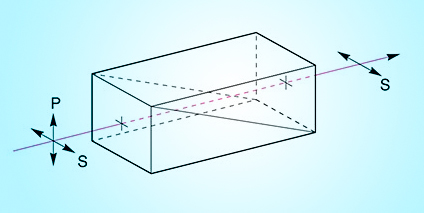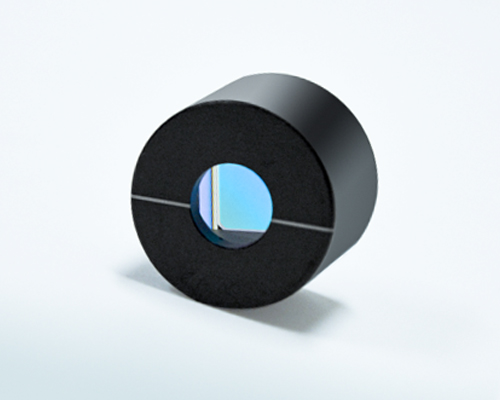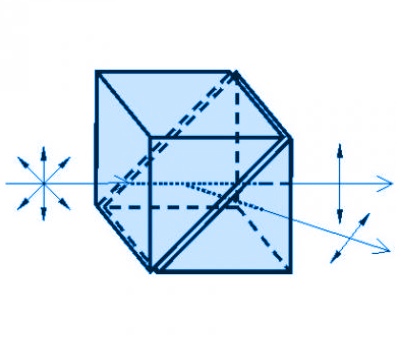Categories of Optical Crystalline Birefringence Polarizers
Introduction:
An Optical Polarizer is an optical element that screens light and split it into two beams with a specific ratio according to its polarization state. One of the most prevalent kinds of optical polarizers is Crystalline Polarizers, which leverage the birefringent characteristic of anisotropic crystals. The common substrate materials include calcite(CaCO3), quartz, (SiO2), beta barium borate (BBO), magnesium fluoride (MgF2), and yttrium vanadate (YVO4). The crystal polarizers are often constructed by two prisms assembled together, and the method of assembling could be manifold, including cemented, optical contacted, and air-spaced. And in general, there are three kinds of birefringence polarizers, Glan Polarizers, Wollaston Polarizers, and Rochon Polarizers. Besides, there are also Polarization Rotators and Depolarizers. In this article, we will be discussing the basic concept of the polarizers and their working principles.
Glan Polarizer:
Glan Polarizers are often manufactured using two calcite prisms (though Glan polarizers could also be made of Alpha-BBO, YVO4) with identical orientations of optical axes parallel to the plane of reflection. Glan polarizers exploit the different refractive indices between the o component and the e component and the critical angle to realize beam splitting. When light is projected perpendicularly to the end face, due to calcite’s birefringence nature, it divides into two components, but both the ordinary component and the extraordinary component do not deviate, their angle of incidence at the interface equals the angle θ between the oblique face and the right-angle face of the prism. θ becoming the incident angle implies that for the o component, the incident angle is greater than the critical angle, which triggers the total internal reflection (TIR). The reflected o component is absorbed by the coating on the interiors of the prism; whilst for e light, the incident angle is smaller than the critical angle, permitting it to pass through, and emit a beam of linearly polarized light. The relative positions of the prisms are deliberately designed so that the ordinary ray exceeds the critical angle and undergoes total internal reflection, and the extraordinary ray continues to propagate. Incidentally, Glan polarizers could be divided into two subclassifications: Glan Thompson Polarizers and Glan Taylor Polarizers. Sometimes, to accommodate high laser powers, manufacturers utilize air-spaced structures and configure the housing with two escape windows to dump excessive energy, Glan Laser Polarizers are such polarizers with such designs aimed to cope with high-power lasers.

Figure 1. Glan Polarizer.
Wollaston Polarizer:
A Wollaston Prism is composed of two prisms with optical axes of each prism in the pair simultaneously perpendicular to one another and perpendicular to the propagating beam. Wollaston prisms can generate two separate beams of linear polarization and perpendicular light vectors. It is often made of two right-angled calcite prisms cemented together.
When a beam of natural light is vertically incident on the terminal surface of the prism, the Wollaston polarizer divides it into two orthogonal polarizations. the o component and e component propagate along the same direction without refraction, but the two components propagate at different speeds Vo and Ve. When the o light and the e light enter the second prism in succession, since the optical axis of the second prism is perpendicular to the optical axis of the first prism, the o light in the first prism becomes e light for the second prism, and the e light becomes For o light. Therefore, the original o-light in the first prism is refracted at the interface of the two prisms with the relative refractive index ne/no, while the original e-light in the first prism is refracted with the relative refractive index no/ne. Because calcite is a negative birefringent crystal, which means no>ne (However Wollaston prisms could also be fabricated using Alpha-BBO, YVO4, and Quartz), the e component in the second prism travels apart from the normal of the interface between the two calcite prism, and the o component in the second prism travels towards the normal of the interface between the two calcite prisms. As a result, a light beam is separated in the second prism. In this manner, after being refracted by the rightmost surface and transmitted from the Wollaston prism, the beams are polarized and split according to a specific angle, and their directions of orientation are perpendicular to each other.

Figure 2. Wollaston Polarizer
Rochon Polarizer:
A Rochon Polarizer is an optical polarizer constructed by two wedge prisms made from uniaxial birefringent materials. Rochon prisms are often utilized to divide a linearly polarized light into two linearly polarized components with orthogonal polarization direction: the ordinary ray and the extraordinary ray. The optical axes of the Rochon polarizer are contrived so that in the first wedge prism both the ordinary and the extraordinary rays propagate along the optical axis, and in the second wedge the light rays propagate perpendicular to the optical axis. The optical axis of one of the wedges is parallel to the normal of incidence, and the optical axis of the other wedge is perpendicular to the plane of incidence.
The ordinary ray (o ray) in the first wedge will be converted into the extraordinary ray (oe ray) in the second wedge, and the extraordinary ray (e ray) will be converted into the ordinary ray (eo ray), conversely. Then the eo ray will not be deviated at normal incidence, while the oe ray is deviated by a splitting angle. The beam deflection angle is determined by the wedge angle of the Rochon prism and the refractive indices of the birefringent material.

Figure 3. Rochon Polarizer
Polarization Rotator:
A polarization rotator is an optical device that rotates the polarization axis of a light beam of linear polarization at a specific angle. Such rotation is essentially the confinement of an electric field vector or magnetic field vector to a given plane along the direction of propagation. The capability that a certain substance could rotate the plane of polarization of plane-polarized light is called optical activity. As compared to a waveplate, a rotator has the innate advantage of being insensitive to rotation around its own optical axis.
Depolarizer:
A depolarizer is an optical component used to scramble the polarization of light. An ideal depolarizer would generate spontaneously polarized light whatever the polarization state of light it received, but all practical depolarizers produce pseudo-random output polarization. Sometimes, when plane polarized beam is not welcomed in some circumstances such as a reflecting spectrometer, a depolarizer will change the plane polarization into a mix of polarization states by jumbling the polarization, the result is to change plane polarized beam into the pseudo-depolarized beam and produce depolarization. Depolarizer is extensively used in polarization-sensitive instruments.
Related Products
Tags: Categories of Optical Crystalline Birefringence Polarizers


